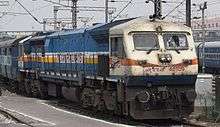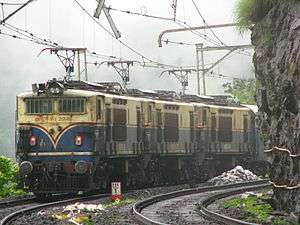Indian locomotive class WDM-3A
The class WDM-3A is Indian Railways' workhorse diesel-electric locomotive. Since 1993, it has been manufactured in India by the Diesel Locomotive Works (DLW), Varanasi. The model name stands for broad gauge (W), diesel (D), mixed traffic (M) engine. The WDM-3A is the most common diesel locomotive of Indian Railways. The WDM-3A is a later classification of earlier WDM-2C.[1] These units have been retro-fitted with dual brakes, in addition to the air and vacuum brakes. The WDM-3A locos have a maximum speed of 120 km/h (75 mph). The gear ratio is 65:18.[2]
| ALCO251C WDM - 3A | |||||||||||||||||||||||||||||||||||||||||||||||||
|---|---|---|---|---|---|---|---|---|---|---|---|---|---|---|---|---|---|---|---|---|---|---|---|---|---|---|---|---|---|---|---|---|---|---|---|---|---|---|---|---|---|---|---|---|---|---|---|---|---|
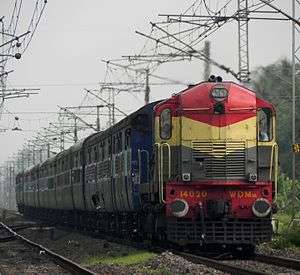 WDM - 3A hauling Padatik Express | |||||||||||||||||||||||||||||||||||||||||||||||||
| |||||||||||||||||||||||||||||||||||||||||||||||||
| |||||||||||||||||||||||||||||||||||||||||||||||||
| |||||||||||||||||||||||||||||||||||||||||||||||||
| |||||||||||||||||||||||||||||||||||||||||||||||||
The loco is now widely used across India for long-distance passenger trains due to its ruggedness and high tractive loads and acceleration.
History
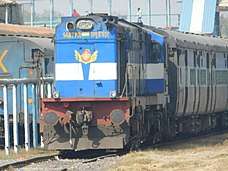
.jpg)
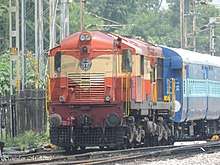
The first one was delivered on August 22, 1994, It was then WDM-2C.[3] First 57 units produced till March 1996 (Indian Railway road number 14001-14057) had rounded front hood profile similar to contemporary newer classes of locos built by DLW (WDG3A and WDP1). After that there was a gap of long four years in the WDM3A production line in DLW. These new locomotives had their control stand shifted to the left side of the cabin. Meanwhile, Diesel Loco Modernisation Works (erstwhile Diesel Modification Works which again was known as Diesel Component Works) in Patiala started rebuilding the existing WDM2 locomotives, which had reached midlife, with upgraded powerpacks. DLMW Patiala re-calibrates the powerpack and upgrades the output power rating to 3100HP.[4] DLW again started building WDM3A from the year 2000 and continued till the end of 2002 with locomotive road numbers in the range 14058–14143. All the locomotives rebuilt by DLMW and later batch from DLW had regular WDM2 type square short hood profile and control stand position. DLW again built WDM3A variant locomotives, during 2005–2006, in the road number range 14144-14167 which were classified as WDM3B due to their difference in bogie design from classic ALCo asymmetrical trimount to HAHS design which was employed in WDG2 and later WDM3D classes too. Most of the WDM3B were later converted to WDM3D. In 2011, DLMW rebuilt locomotive number 16502 as WDM3A and equipped it with an Electronic Fuel Injection (EFI) system jointly developed by Engine Research Laboratory of IIT Kanpur, Engine Development Directorate of RDSO, and DLMW Patiala.[5] DLMW continues to rebuild WDM2 as WDM3A and recently they have started rebuilding the DLW built WDM3A too when they reach their midlife. Recent rebuilt locomotives are rated at 3300 HP, and from 2009 onward they are equipped with Daulat Ram DBR, and since 2014 they are also equipped with an Auxiliary Power Unit (APU) in the short hood.[6] Some rebuilt locomotives have Co-Co-fabricated ATHS (Advanced Trimount High Speed) bogies instead of ALCo cast-iron type.[7] All the rebuilt WDM3A bear the "-R" suffix to their road numbers.
In 2012 Bangladesh Railway ordered 26 WDM3A from DLW. They are classified as Class 6500 there. These units, however, lack the dynamic braking which happens to be an essential component in their Indian counterparts.
Sub Class
WDM-3B: The WDM3B diesel locomotive class was developed in 2005 after the WDM3C and WDM3D. It actually is a variant of the WDM3D, though it shares its power rating with the WDM3A. Only 23 numbers were built (road numbers #14144 to #14167), making them very rare. It has the same engine as the WDM3D, despite having a power deficit of 200 hp. It also looks the same, shares the same body shell, control cabin, undercarriage and the high-adhesion bolsterless bogies of the WDM3D. The difference is that unlike the WDM3D, the WDM3B is not microprocessor controlled but uses something called “E-Type Excitation” for locomotive control. The WDM3B seems to be the result of the Railways trying to cut the WDM3D down to size by eliminating its troublesome features like microprocessor control. But now 3Bs are being converted into 3Ds. WDM3Bs are housed at UP sheds like Lucknow, Gonda, Jhansi, Samastipur, Patratu etc. and many are (were) famously named “Gajraj”. The WDM3B does not adhere to the hp-based naming convention as WDM3A already represented 3100 hp. IR just assigned the vacant WDM3B class to this type.[8]
WDM-3C: They were just upgraded and more powerful WDM3As with the ALCO engine gain rebuilt to output 3300 hp. It was the first follow-up experiment after the WDM-3A to squeeze more power out of the ALCO engine, an intermediary that would later lead to the development of the WDM-3D. Not many were produced, all of which were rebuilds of the WDM2 or WDM3A and were identical to the previous variants in every aspect. They can no longer be found over the railway network as all of them have been rebuilt into the WDM-3A or WDM-2 type.[9]
WDM-3D: While still being based on the good old ALCO, the WDM3D was a groundbreaking kind of locomotive for the Indian Railways, the “real” next generation” after the WDM-3A. With the WDM-3D, IR finally got it right on how to rebuild the old ALCO engine to produce 3300 hp. By this time, EMDs had become a staple of the scene and along with the rebuilt engine, the brilliant DLW and RDSO engineers were now successful at integrating the best features of EMD locomotives like microprocessor control, larger fuel tanks and oil sump, possible fiberglass cabin and improved control stands into the ALCO, making it a kind of EMD-ALCO hybrid! These locomotives can be easily distinguished from other ALCOs by the “narrower” body shell with much walkway space around it, full-length railings, predominant “platform” space extended up front of the long hood, solid cowcatcher and DBRs fitted on the roof of the unblemished, smooth short hood for some later models and rebuilds, giving them the “hoodie” look. Comparing with the WDM3A, the WDM3D can carry 1.5 tonne more axle load and generates 8 tonnes more Maximum Tractive Effort. The engine is classified WDM3D though it outputs only 3300 hp and not 3400 hp as the name should suggest. Earlier WDM3Ds had issues with their electronics which probably led to the interim development of the WDM3B in 2005, basically a lower powered WDM3D without microprocessor control. Their Road Numbers start from #11001. The WDM3D along with the WDG3A are the only ALCO models currently in production and mostly haul express services.[10]
WDM-3E: This was an experimental class developed out of the WDM3D by IR on the ever-lookout for more power, all equipped with High Adhesion bogies and roof-mounted DBRs. However, they never entered serial production. Some suggest that the WDM3E is actually called “WDM3D without Equalizer” or WDM3Ds with 3500 hp power. The known road numbers in service for this class are #11306 to #11311 and #11263. All are marked WDM3D and all are used to haul only freights with speed restricted to 85 kph. They look exactly like the WDM3D and share all its features.[11]
WDM-3F:The very extremely rare WDM3F was the result of the last and final experiment in IR’s drive for more powerful ALCOs. This one is rated 3600 hp and only four were produced (#11287, #11321, #11325, #11342). #11287 has a unique aerodynamic design where the ends taper upwards (picture above). All WDM3Fs are based at Gooty (GY) and share all the features of the WDM3D including roof mounted DBRs except the #11287. Though high powered, this class apparently didn’t work out well because after the WDM3F, IR realized that it is futile to try and crank more power of the ALCOs as they were too old and outdated and shifted attention to the EMD. This also marked the beginning of the end of the ALCO domination on Indian Railways.[12]
Locomotive sheds
| Zone | Name | Shed Code | Quantity |
|---|---|---|---|
| Central Railway | Pune | PA | 16 |
| Kurla | CLA | 4 | |
| Eastern Railway | Howrah | HWH | 10 |
| Bardhaman | BWN | 70 | |
| Andal | UDL | 12 | |
| Jamalpur | JMP | 39 | |
| East Central Railway | Patratu | PTRU | 17 |
| Pt. DD Upadhyaya Junction | DDU | 18 | |
| Samastipur | SPJ | 32 | |
| East Coast Railway | Visakhapatnam | VSKP | 36 |
| Northern Railway | Tughlakabad | TKD | 34 |
| Ludhiana | LDH | 105 | |
| Lucknow | LKO | 25 | |
| North Central Railway | Jhansi | JHS | 31 |
| North Eastern Railway | Gonda | GD | 99 |
| Northeast Frontier Railway | Malda Town | MLDT | 58 |
| Guwahati | NGC | 15 | |
| North Western Railway | Abu Road | ABR | 68 |
| Southern Railway | Erode | ED | 4 |
| Ernakulam | ERS | 34 | |
| Golden Rock | GOC | 11 | |
| Tondiarpet | TNP | 20 | |
| South Central Railway | Kazipet | KZJ | 28 |
| Gooty | GY | 11 | |
| Guntakal | GTL | 28 | |
| Moula Ali | MLY | 21 | |
| South Eastern Railway | Kharagpur | KGP | 31 |
| Bondamunda | BNDM | 24 | |
| Bokaro Steel City | BKSC | 24 | |
| South East Central Railway | Raipur | R | 30 |
| South Western Railway | Krishnarajapuram | KJM | 22 |
| Western Railway | Ratlam | RTM | 30 |
| Vatva | VTA | 48 | |
| West Central Railway | Itarsi | ET | 56 |
| New Katni Junction | KTE | 47 | |
| Total Locomotives Active as of 01-06-2020[13] | 1158 | ||
Technical specifications
Technical details are as follows:[14][15]
| Manufacturers | DLW, DLMW (DMW/DCW) |
| Engine | Alco 251-C, 16 cylinder, 3,300 hp (2,500 kW), earlier 3,100 hp (2,300 kW) (3,007 hp or 2,242 kW site rating, earlier 2,900 hp (2,200 kW)) with Napier NA2951R/ ABB VTC-304-VG15/ GE 7s 1716 turbo supercharged engine. 1,050 rpm max, 400 rpm idle; 228.6 mm × 266.7 mm (9.00 in × 10.50 in) bore x stroke; compression ratio 12.5:1. Direct fuel injection, centrifugal pump cooling system (2,457 L/min (540 imp gal/min; 649 US gal/min) at 1,050 rpm), fan driven by eddy current clutch (90 hp or 67 kW at 1,050 rpm) |
| Governor | EDC / Woodward 8574-650 |
| Transmission | Electric, with BHEL TA 10102 CW alternator (1,050 rpm, 1100 V, 4,400 amperes) (Earlier used BHEL TG 10931 AZ alternator) |
| Traction motors | BHEL TM 4906 AZ/ 4907 BZ (435 hp or 324 kW) (with roller bearings) |
| Axle load | 18.8 tonnes (18.5 long tons; 20.7 short tons), total weight 112.8 t (111.0 long tons; 124.3 short tons) |
| Bogies | Alco design cast frame asymmetric trimount (Co-Co) bogies |
| Starting TE | 30.45 t (29.97 long tons; 33.57 short tons) at adhesion 27%, continuous 28.05 t (27.61 long tons; 30.92 short tons) |
| Length over buffer beams | 15,862 mm (52 ft 1⁄2 in) |
| Distance between bogies | 10,516 mm (34 ft 6 in) |
See also
References
- Agarwal, Avinash Kumal; Dhar, Atul; Gautam, Anirudh; Pandey, Ashok, eds. (2017). Locomotives and Rail Road Transportation - Technology, Challenges and Prospects. Springer. p. 16. ISBN 978-981-10-3787-0. LCCN 2017930134 – via Google Books.
- "About WDM-3A". Indian Railways Fan Club.
- "IR History: Part - V (1970-1995)". Indian Railways Fan Club. Retrieved August 22, 2017.
- (PDF). Indian Railways http://www.dmw.indianrailways.gov.in/works/uploads/File/Company%20Profile.pdf. Retrieved March 2, 2018. Missing or empty
|title=(help) - "Direction Article Development of EFI for 204-stroke locomotive diesel engine" (PDF). iitk.ac.in. Indian Railways. 2018. Retrieved March 2, 2018.
- "Company Profile" (PDF). indianrailways.gov.in. Indian Railways. Retrieved March 2, 2018.
- "Motive Power" (PDF). indianrailways.gov.in. RDSO. 2018. Retrieved March 2, 2018.
- "Diesel Loco Roaster WDM(ALCO) series".
- "Diesel Loco Roaster WDM(ALCO) series".
- "Diesel Loco Roaster WDM(ALCO) series".
- "Diesel Loco Roaster WDM(ALCO) series".
- "Diesel Loco Roaster WDM(ALCO) series".
- "Railway Website Mechanical Department". Retrieved 16 May 2020.
- "Diesel Locomotive Classes – Broad Gauge". Indian Railways Fan Club.
- "Diagram Book of WDM2C Locomotive" (PDF). RDSO.

